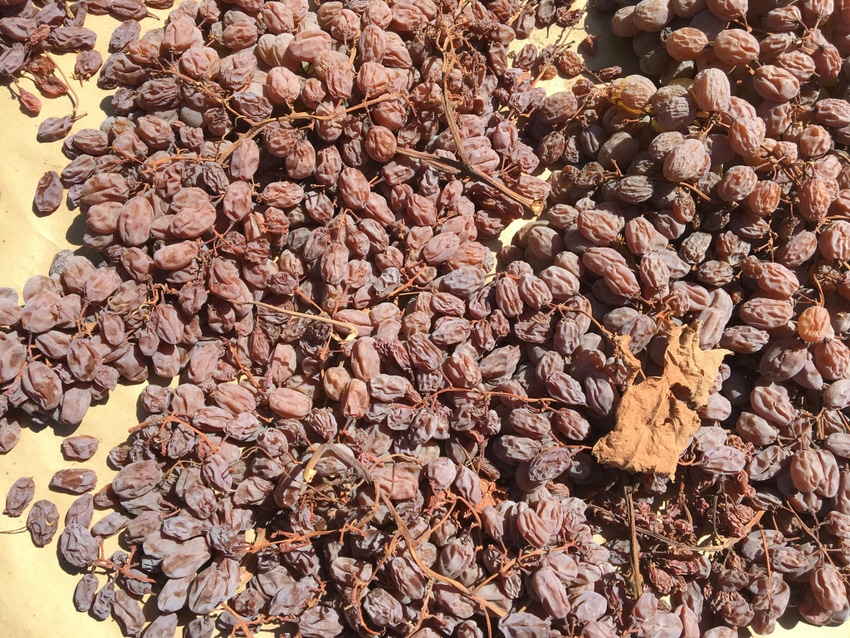
By the first week of May, with daytime temperatures in the Fresno, Calif., area reaching well into the 90s, Kalem Barserian, CEO and general manager of the Raisin Bargaining Association, described development of the 2017 raisin crop as pretty close to normal.
“The vines are growing nicely and there’s plenty of water for irrigation,” he says. “Overall, things are looking good in the vineyards.”
Up until the end of April, however, temperatures since bud break had been a little cooler than usual, Barserian notes. “Heat units are what count. So, even if the vines are behind a few days at this stage, there’s plenty of time to pick up the heat units for the crop to be maturing at the normal rate by Sept. 1.”
In fact, this year’s lower-than-usual bunch counts – the second in a row – are likely to help accelerate sugar development and ripening of the grapes, since the vines will have less fruit to support.
Typically, Thompson-seedless and other raisin-type varieties produce somewhere around 40 clusters per vine. This year, two different industry surveys show bunch counts ranging from about 28 to 31. That compares to bunch counts of 43 in 2015 and 34 in 2016.
“At this point in the season, we’re expecting raisin grape yields of around 9 tons per acre,” he says.
California growers produced 9.5 tons of raisin grapes per acre last year and 10.8 tons per acre in 2015.
Lower yields and continued conversion of raisin grape ground this year to orchards of tree nuts or other more lucrative crops should contribute to an upswing in prices growers receive for their 2017 raisins, Barserian notes.
Last year’s raisin price was $1,100 per ton – 31 percent under the $1,600 per ton growers received for their 2015 crop.
Much of that drop in price reflected pressure from a seven-month supply of unsold raisins remaining in processors’ inventories at the start of the 2016 harvest, Barserian says. But, those stocks are dwindling and imports of raisins have slowed. As a result, he’s expecting the market for California raisins to start turning around this year.
So far this year, domestic shipments of raisins are up 4 percent and exports have risen 14 percent over last year. Also, the federal government has announced the purchase of 11,000 tons of raisins for school lunch and other food distribution programs to be shipped between May 15 and Nov. 30 of this year.
What’s more, imports of raisins began dropping last year as packers started selling inventory when raisin prices dropped below both grower and packer costs. In 2015, imports of raisins from Argentina, Chile and South Africa, among a few of the importing countries, totaled about 25,000 tons. That figure declined to 21,000 tons last year and continues to fall due to weather-related production shortfalls in Argentina and South Africa and attractive prices for table grapes in Chile that reduced the supply of green grapes available to make raisins.
“California packers are looking to reduce their inventories from 158,000 tons on Aug. 1, 2016, to less than 125,000 tons by Aug. 1 of this year, the start of the 2017-18 marketing year,” Barserian says. “So the industry is closing in on the much more manageable 100,000 tons of inventory we like to have on hand prior to harvesting a new crop.
“Also, we’re expecting total raisin production this year to be way below 300,000 tons. That should result in a better balance of supply and demand for the 2017 crop and a better price for growers.”
Since Aug. 1, 2016, growers have delivered 271,000 tons of raisins to packers. Production of raisin grapes was estimated at 288,000 tons for the 2016 fiscal year, which began Aug. 1. 2016.
Meanwhile, the production base of California’s raisin industry continues to shrink as growers respond to market prices and the increasing cost and decreasing availability of labor. From the year 2000 when acreage of bearing raisin-type grapes totaled 280,000, the number of bearing acres had dwindled to 165,000 by the end of 2016.
“Last year, alone, 14,000 acres of raisin vines were taken out of production,” Barserian says. “And a lot of additional acres have been pushed out and burned so far this year.”
About the Author(s)
You May Also Like




